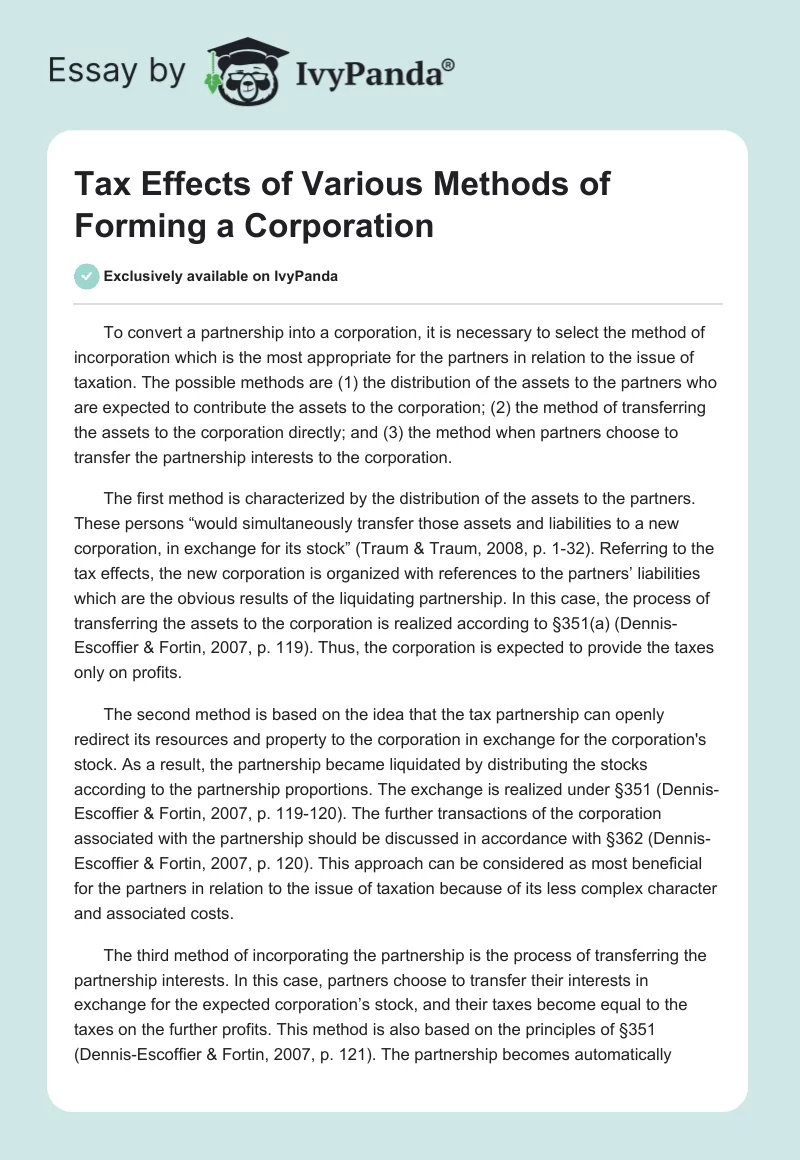To convert a partnership into a corporation, it is necessary to select the method of incorporation which is the most appropriate for the partners in relation to the issue of taxation. The possible methods are (1) the distribution of the assets to the partners who are expected to contribute the assets to the corporation; (2) the method of transferring the assets to the corporation directly; and (3) the method when partners choose to transfer the partnership interests to the corporation.
The first method is characterized by the distribution of the assets to the partners. These persons “would simultaneously transfer those assets and liabilities to a new corporation, in exchange for its stock” (Traum & Traum, 2008, p. 1-32). Referring to the tax effects, the new corporation is organized with references to the partners’ liabilities which are the obvious results of the liquidating partnership. In this case, the process of transferring the assets to the corporation is realized according to §351(a) (Dennis-Escoffier & Fortin, 2007, p. 119). Thus, the corporation is expected to provide the taxes only on profits.
The second method is based on the idea that the tax partnership can openly redirect its resources and property to the corporation in exchange for the corporation’s stock. As a result, the partnership became liquidated by distributing the stocks according to the partnership proportions. The exchange is realized under §351 (Dennis-Escoffier & Fortin, 2007, p. 119-120). The further transactions of the corporation associated with the partnership should be discussed in accordance with §362 (Dennis-Escoffier & Fortin, 2007, p. 120). This approach can be considered as most beneficial for the partners in relation to the issue of taxation because of its less complex character and associated costs.
The third method of incorporating the partnership is the process of transferring the partnership interests. In this case, partners choose to transfer their interests in exchange for the expected corporation’s stock, and their taxes become equal to the taxes on the further profits. This method is also based on the principles of §351 (Dennis-Escoffier & Fortin, 2007, p. 121). The partnership becomes automatically terminated as a result of such operations (Traum & Traum, 2008, p. 1-33). It is important to note that the partners cannot gain profits or experience losses as a result of the process of incorporating the partnership.
A partnership as the business structure uniting two or more persons does not pay taxes. That is why, for JPG Partnership, it is necessary to choose the method of incorporating the partnership which is the most advantageous for the partners in relation to taxes. According to the Internal Revenue Service (IRS), partners are expected to pay self-employment taxes. As a result, while transferring the assets to the corporation, the partners should note changes in the conditions and terms. Having organized a corporation, the partners belonging to the former JPG Partnership should be discussed as the shareholders who have the stock in the newly corporation. That is why, the corporation would pay income taxes on profits, and the partners who became shareholders cannot be discussed as responsible for paying taxes. In this case, to contribute to the newly organized corporation, it is possible to choose the second method of transferring the assets because of its easiness and advantages related to the taxation policies.
References
Dennis-Escoffier, S., & Fortin, K. (2007). Taxation for decision makers. USA: Cengage Learning.
Traum, S., & Traum, J. (2008). S Corporation Answer Book. USA: Aspen Publishers Online.


